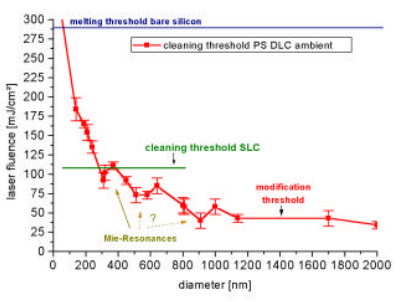We report on experiments on the underlying physical mechanisms in the Dry- (DLC) and Steam Laser Cleaning (SLC) process. Using a frequency doubled, Q-switched Nd:YAG laser (FWHM=8 ns) we removed polystyrene (PS) particles with diameters from 110-2000 nm from industrial silicon wafers by the DLC process. The experiments have been carried out both in ambient conditions as well as in high vacuum (10-6 mbar) and the cleaned areas have been characterized by atomic force microscopy for damage inspection. Besides the determining the cleaning thresholds in laser fluence for a large interval of particle sizes we could show that particle removal in DLC is due to a combination of at least three effects: thermal substrate expansion, local substrate ablation due to field enhancement at the particle and explosive evaporation of adsorbed humidity from the air. Which effect dominates the process is subject to the boundary conditions. For our laser parameters no damage free DLC was possible, i.e. whenever a particle was removed by DLC we damaged the substrate by local field enhancement. In our SLC experiments we determined the amount of superheating of a liquid layer adjacent to surfaces with controlled roughness that is necessary for bubble nucleation. On smooth surfaces high superheatings were necessary, in good agreement with theoretical predictions. Rough surfaces exhibited only a much smaller superheating.
In the production of integrated circuits one major source for production losses and malfunctions of the devices is the contamination of the silicon substrates by particles. Against the background of further shrinking linewidths of ICs (130 nm by the end of this year) it is clear that a fundamental requirement for the success in this field is the availability of a cleaning method capable of removing particles much smaller than 100 nm in diameter. Although traditional cleaning methods like ultra- and megasonics or brushing are continuously improved, it is not clear so far whether they will meet future demands in the semiconductor industry.
One of the new cleaning methods discussed as a possible complement to already existing procedures is laser cleaning. In Dry Laser Cleaning (DLC) the surface to be cleaned is irradiated by a short laser pulse. In Steam Laser Cleaning (SLC) prior to the application of the laser pulse a liquid, e.g. a water-alcohol mixture, is condensed onto the surface.
Although laser cleaning is known for more than ten years now, still many questions related to the underlying physical processes are not answered. The authors of the first publications on the subject [1-4] suggested simple physical scenarios that were accepted for the interpretation of experimental data thereafter and were taken as a basis for theoretical modeling. Almost all authors explained DLC solely by the thermal expansion of the substrate and the adhering particle, SLC by explosive evaporation of the liquid condensed onto the surface.

Fig1
Under ambient conditions particle removal in the cleaned area (about 1 mm 2 ) was detected by a light scattering technique . A 5 mW HeNe laser illuminated a spot with a diameter of 0.5 mm, which corresponds to several hundred particles monitored, its scattered light was detected by a photomultiplier. The monitored area was much smaller than the illuminated area, therefore in this case the laser fluence can be considered as almost homogeneous. In HV we determined the fluences necessary for particle removal by inspecting the illuminated spot with an optical microscope prior and after the laser pulse. We measured the threshold cleaning fluence relatively to the melting threshold of Si, monitoring the reflected light of the HeNe laser with ns time resolution. As the laser fluence for the onset of melting of silicon is well known, this can be used for a conversion of relative fluences into absolute numbers.
A first step in the investigation of DLC is the study of particle removal in ambient conditions. This environment represents the conditions that may be found in a possible future application of the process.